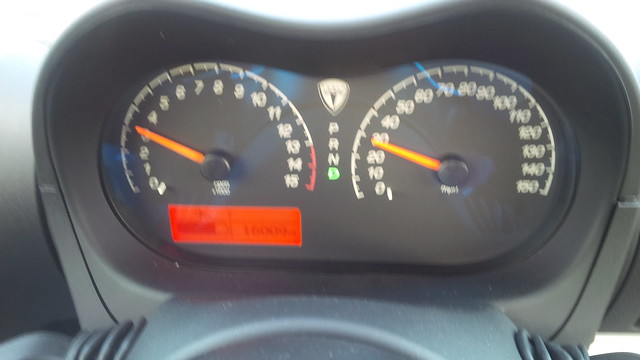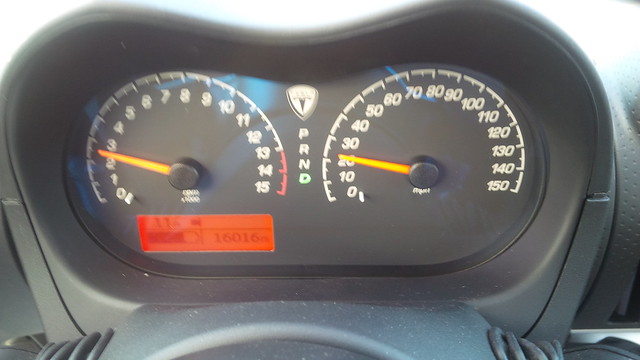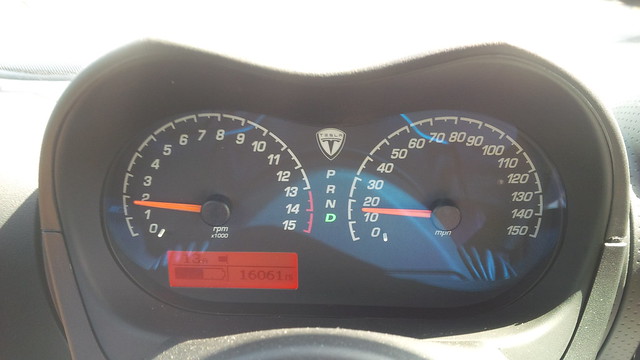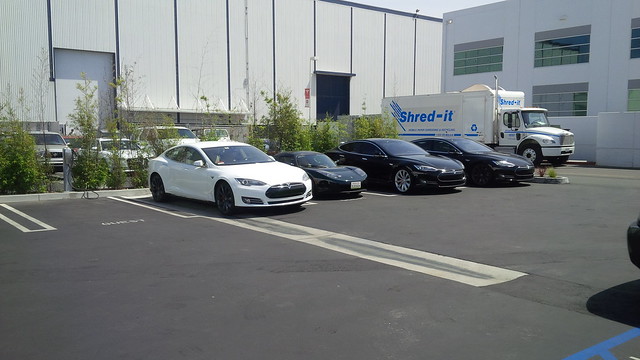Got to take the Roadster out for a “spin” this past week and it hit 16,000 miles in the process…
Unfortunately, I didn’t catch it at 16,000, so I remembered at 16,009 miles… But that’s kinda boring.
So, I thought, 16,016 miles would be a good shot…
Well… That’s nice, but not quite “memorable” enough for me. I figure a palindrome would be better…
So, let me present… 16,061 miles…
Now… What have we learned in the nearly 14,000 miles that we’ve owned the Roadster. Well. It’s squeeky. Especially with the hardtop on.
I spent part of my day stopping by the Tesla Motors Hawthorne Design Center (also known as the site of the original Tesla Los Angeles Supercharger.) It’s now pretty empty, looks like more people stop off at Culver City or Redondo Beach now that those two are open. I stopped off at the Design Center because they have a bank of eight Model S HPWCs for folks that don’t need to supercharge.
I thought the start of charge looked promising (started around 205V and 61A) the rate with which the Roadster with the CAN SR charged fluctuated between 205-208V and 44A. That’s not much faster than using a 40A UMC at 240V at home. Still, I wanted to see the behavior, so I stuck around for a little while to recover some miles and hung out with a few Model S at the center.
Here’s a Panoramic of the eight HPWCs with Model S charging at the occupied ones, with the exception of HPWC 6 which I was charging at:
The HPWCs were all well labeled, and I only tested one of them, so, I don’t know whether the others will provide the full 80A to a Model S or 70A to a Roadster with the CAN SR. I posted my statistics on teslamotorsclub.com and Henry Sharp (hcsharp) advised that perhaps the PEM was overheating. I was driving for a while before the stop, so that could have affected it. I know that the adapter and car work at 70A because I’ve had it tested at the Service Center on a Model S HPWC and I’ve seen it at that speed on OVMS. So, I’ll have to try charging it with a cooler PEM in the future.
It would seem that what looks like premature battery degradation on the Roadster can be rehabilitated. Since then, we’ve been closer to a CAC closer to 149 and full standard daily ranges closer to 177-179 miles. One of the things that we’ve done since July of last year has been to leave the car unplugged until it really needed to charge. In general, in a protected garage, the vampire losses on the Roadster are minimal, especially compared with the Model S. So, what does this mean? The battery on the Roadster seems to perform better when you let the charge drop low (but not too low.) We’ve been advised to let the car drop to 40 miles or slightly less at least once a week. We do this closer to lower than 60 miles of range rather than 40. It’s just how the math works with the car’s usage patterns. For the record, the Service Center did a range charge the last time I had it in and that looked to reach 226 miles in Range Mode. So, that’s increased as well.
Another thing that we learned in the approximately 14,000 miles that we’ve owned the Roadster, is that the squeaks can be taken care of, at least for a while. There is some sort of lubricant that the center applies to the hardtop to take care of these squeaks.
The car’s not so squeaky with the soft-top, but we like to use the hardtop, so squeaks it is.
Apparently, before installing the hardtop, apply some of the substance above to the parts of the roof and car that touch each other and it lessens the squeaks. And it works great. For a while. However, a Roadster is not the comfortable car that the Model S is. It’s a driver’s car, and the adrenaline that comes with driving it is really part of the “fun.”





